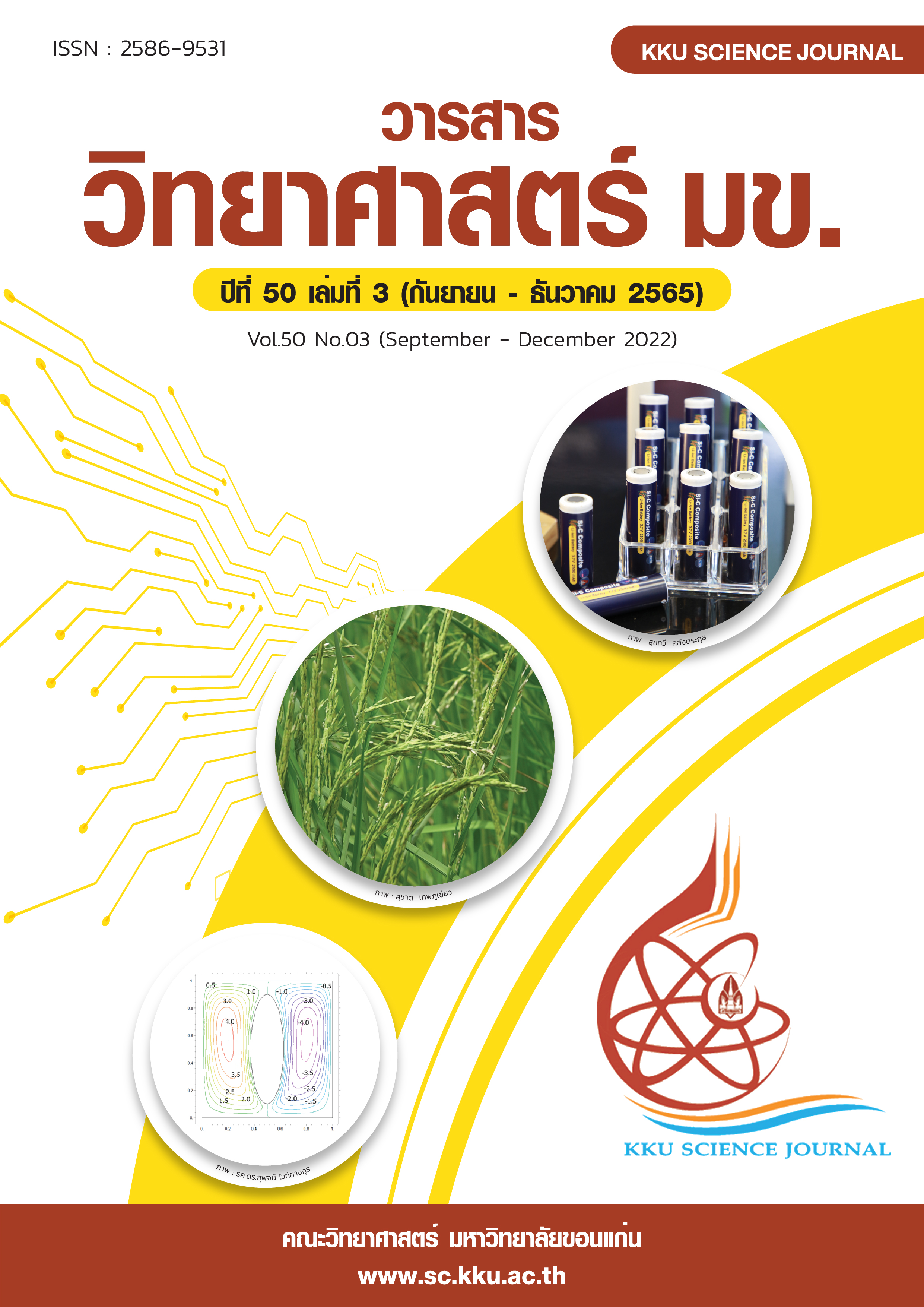Conservation status of Gynura in Thailand
Main Article Content
Abstract
Conservation status of Gynura (Asteraceae) in Thailand was investigated. Thirteen taxa of Gynura were recorded in Thailand. Among these, six taxa are endemic to Thailand. The conservation status was analyzed based on distributional data from herbarium specimens and field surveys throughout Thailand in 2018 using ConR Program. The status was categorized under criterion B of International Union for Conservation of Nature (IUCN). The results indicated that seven taxa are threatened. Gynura divaricata (L.) DC. and G. truncata Kerr are critically endangered species (CR). Gynura calciphila var. dissecta F.G. Davies, G. cusimbua (D. Don) S. Moore, G. hmopaengensis H. Koyama and G. nepalensis DC. are endangered species (EN). G. siamensis Vanij. & Kadereit is vulnerable species (VU). The other six taxa are categorized as near threatened species (NT) or least concern (LC). This information is useful for plant conservation management.
Article Details

This work is licensed under a Creative Commons Attribution-NonCommercial-NoDerivatives 4.0 International License.
References
Aytaç, Z., Duman, H. and Ekici, M. (2016). Two new Achillea L. (Asteraceae) species from Turkey. Turkish Journal of Botany 40: 373–379.
Chamchumroon, V., Suphuntee, N., Tetsana, N., Poopath, M. and Tanikkool, S. (2017). Threatened plant in Thailand. Department of National Parks, Wildlife and Plant Conservation.
Clements, R., Sodhi, N.S., Schilthuizen, M. and Ng, P.K.L. (2006). Limestone karsts of Southeast Asia: Imperiled arks of biodiversity. BioScience 56(9): 733.
Corlett, R.T. (2016). Plant diversity in a changing world: status, trends, and conservation needs. Plant Diversity 38(1): 10–16.
Dauby, G., Stévart, T., Droissart, V., Cosiaux, A., Deblauwe, V., Simo-Droissart, M., Sosef, M. S.M., Lowry, P.P., Schatz, G.E., Gereau, R.E. and Couvreur, T.L.P. (2017). ConR: An R package to assist large-scale multispecies preliminary conservation assessments using distribution data. Ecology and Evolution 7(24): 11292–11303.
Davies, F.G. (1978). The genus Gynura (Compositae) in Africa. Kew Bulletin 33(2): 335.
Forest and Plant Conservation Research Office, The Forest Herbarium, Department of National Parks, Wildlife and Plant Conservation. (2011). Thailand Important Plant Areas: IPAs. Forest and Plant Conservation Research Office, The Forest Herbarium, Department of National Parks, Wildlife and Plant Conservation.
Gaston, K.J. and Fuller, R.A. (2009). The sizes of species’ geographic ranges. Journal of Applied Ecology 46(1): 1–9.
IUCN. (2012). IUCN Red List Categories and Criteria: Version 3.1. (2nd ed.). Gland, Switzerland and Cambridge, UK.
Koyama, H. (1988). Taxonomic studies in the Compositae of Thailand 8. Acta Phytotaxonomica et Geobotanica 39(4–6): 151–163.
Koyama, H., Bunwong, S., Pornpongrungrueng, P. and Hind, D.J.N. (2016). Compositae (Asteraceae). In Flora of Thailand. vol. 13, part 2. Bangkok: Prachachon Co. Ltd. pp. 143–428.
Larsen, K. and Warncke, E. (1966). Report on the Flora of Thailand project – I. Expedition. The Natural History Bulletin of the Siam Society 21: 251–262.
Mullu, D. (2016). A review on the effect of habitat fragmentation on ecosystem. Journal of Natural Sciences Research 6(15): 1–15.
Myers, N., Mittermeier, R.A., Mittermeier, C.G., da Fonseca, G.A.B. and Kent, J. (2000). Biodiversity hotspots for conservation priorities. Nature 403(6772): 853–858.
Office of Natural Resources and Environmental Policy and Planning. (2009). The method to protect, control and destroy alien species. Bangkok: Ministry of Natural Resources and Environment.
Parnell, J.A.N., Simpson, D.A., Moat, J., Kirkup, D.W., Chantaranothai, P., Boyce, P.C., Bygrave, P., Dransfield, S., Jebb, M.H.P., Macklin, J., Meade, C., Middleton, D.J., Muasya, A.M., Prajaksood, A., Pendry, C.A., Pooma, R., Suddee, S. and Wilkin, P. (2003). Plant collecting spread and densities: their potential impact on biogeographical studies in Thailand. Journal of Biogeography 30(2): 193–209.
Pooma, R., Suddee, S., Chamchumroon, V., Koonkhunthod, N., Phattarahirankanok, K., Sirimongkol, S. and Poopath, M. (2005). A preliminary check-list of threatened plants in Thailand. Bangkok: The agricultural cooperative federation of Thailand., Ltd.
Rivers, M.C., Bachman, S.P., Meagher, T.R., Nic Lughadha, E. and Brummitt, N.A. (2010). Subpopulations, locations and fragmentation: applying IUCN red list criteria to herbarium specimen data. Biodiversity and Conservation 19(7): 2071–2085.
Rodrigues, A., Pilgrim, J., Lamoreux, J., Hoffmann, M. and Brooks, T. (2006). The value of the IUCN Red List for conservation. Trends in Ecology and Evolution 21(2): 71–76.
Rodríguez, J.P., Keith, D.A., Rodríguez-Clark, K.M., Murray, N.J., Nicholson, E., Regan, T.J., Miller, R.M., Barrow, E.G., Bland, L.M., Boe, K., Brooks, T.M., Oliveira-Miranda, M.A., Spalding, M. and Wit, P. (2015). A practical guide to the application of the IUCN Red List of Ecosystems criteria. Philosophical Transactions of the Royal Society B: Biological Sciences 370(1662): 20140003.
Schatz, G.E. (2002). Taxonomy and herbaria in service of plant conservation: lessons from Madagascar’s endemic families. Annals of the Missouri Botanical Garden 89(2): 145–152.
Vanijajiva, O. (2009). The genus Gynura (Asteraceae: Senecioneae) in Thailand. Thai Journal of Botany 1(1): 25–36.
Vanijajiva, O. and Kadereit, J.W. (2011). A revision of Gynura (Asteraceae: Senecioneae). Journal of Systematics and Evolution 49(4): 285–314.
Vanijajiva, O and Kundee, N. (2014). Genetic uniformity of exotic medicinal plant Gynura divaricata in Thailand. Phranakhon Rajabhat Research Journal 9(1): 77–86.


